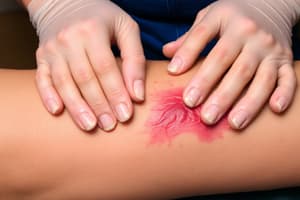Podcast
Questions and Answers
What is the primary reason excessive pressure causes ischemic injury in tissues?
What is the primary reason excessive pressure causes ischemic injury in tissues?
- It decreases oxygen levels in the bloodstream.
- It enhances nutrient absorption in the cells.
- It results in occlusion of capillary flow. (correct)
- It increases metabolic rate in tissues.
Which bony prominence is primarily affected by pressure injuries?
Which bony prominence is primarily affected by pressure injuries?
- Sacrum
- Ischial tuberosities (correct)
- Heel
- Greater trochanter
At what perfusion pressure does local tissue ischemia typically begin to occur?
At what perfusion pressure does local tissue ischemia typically begin to occur?
- 30 mmHg (correct)
- 10 mmHg
- 20 mmHg
- 40 mmHg
What is the main purpose of negative pressure wound therapy (NPWT)?
What is the main purpose of negative pressure wound therapy (NPWT)?
What stage of pressure sore is characterized by non-blanching erythema over intact skin?
What stage of pressure sore is characterized by non-blanching erythema over intact skin?
How often should patients at risk for pressure injuries be repositioned?
How often should patients at risk for pressure injuries be repositioned?
Which pressure sore stage involves full thickness injury extending down to but not including fascia?
Which pressure sore stage involves full thickness injury extending down to but not including fascia?
What tissue pressure can be experienced over the sacrum while lying supine?
What tissue pressure can be experienced over the sacrum while lying supine?
What is the key management strategy for preventing pressure injuries?
What is the key management strategy for preventing pressure injuries?
What is the most common type of basal cell carcinoma?
What is the most common type of basal cell carcinoma?
Which statement best describes the appearance of morpheaform basal cell carcinoma?
Which statement best describes the appearance of morpheaform basal cell carcinoma?
What is a significant risk factor associated with the development of basal cell carcinoma?
What is a significant risk factor associated with the development of basal cell carcinoma?
What is a notable characteristic of basal cell carcinoma regarding its local invasion?
What is a notable characteristic of basal cell carcinoma regarding its local invasion?
Which type of basal cell carcinoma is characterized by fingerlike extensions?
Which type of basal cell carcinoma is characterized by fingerlike extensions?
In which locations is basal cell carcinoma most commonly found?
In which locations is basal cell carcinoma most commonly found?
Which of the following characteristics is NOT true about lipomas?
Which of the following characteristics is NOT true about lipomas?
What indicates a potential malignant transformation in a neurofibroma?
What indicates a potential malignant transformation in a neurofibroma?
Which statement correctly describes neurofibromatosis?
Which statement correctly describes neurofibromatosis?
Which type of tumor is characterized as a malignant fatty tumor that can mimic lipoma?
Which type of tumor is characterized as a malignant fatty tumor that can mimic lipoma?
What is the primary treatment consideration for neurofibromas?
What is the primary treatment consideration for neurofibromas?
Which of the following describes Lisch nodules?
Which of the following describes Lisch nodules?
What is the distinguishing feature of neurofibromas?
What is the distinguishing feature of neurofibromas?
Which condition is indicated by the presence of café au lait spots?
Which condition is indicated by the presence of café au lait spots?
When should you be concerned about the presence of pain in a neurofibroma?
When should you be concerned about the presence of pain in a neurofibroma?
What best describes the growth pattern of lipomas?
What best describes the growth pattern of lipomas?
Which type of necrotizing soft tissue infection is associated with the presence of both Gram-positive cocci and anaerobic bacteria?
Which type of necrotizing soft tissue infection is associated with the presence of both Gram-positive cocci and anaerobic bacteria?
What common comorbidity is particularly important to consider when assessing patients with skin complaints?
What common comorbidity is particularly important to consider when assessing patients with skin complaints?
Which organism is specifically associated with Type III necrotizing fasciitis, particularly in traumatized skin of sea divers?
Which organism is specifically associated with Type III necrotizing fasciitis, particularly in traumatized skin of sea divers?
What physical examination finding might indicate the presence of gas-forming bacteria in a skin lesion?
What physical examination finding might indicate the presence of gas-forming bacteria in a skin lesion?
Which of the following best describes a Dermatofibroma?
Which of the following best describes a Dermatofibroma?
What is a significant risk factor for Type II necrotizing fasciitis related to the patient's history?
What is a significant risk factor for Type II necrotizing fasciitis related to the patient's history?
Which bacteria contribute to a growing number of necrotizing soft tissue infections in the community?
Which bacteria contribute to a growing number of necrotizing soft tissue infections in the community?
In wound healing assessments, what must be determined about the causative agent?
In wound healing assessments, what must be determined about the causative agent?
Which of the following conditions would NOT commonly be associated with necrotizing soft tissue infections?
Which of the following conditions would NOT commonly be associated with necrotizing soft tissue infections?
Which type of necrotizing infection is primarily monomicrobial, often featuring beta-hemolytic streptococci?
Which type of necrotizing infection is primarily monomicrobial, often featuring beta-hemolytic streptococci?
What is the primary cellular component making up skin tags?
What is the primary cellular component making up skin tags?
Which type of cyst is characterized by keratin accumulation due to epidermis overgrowth?
Which type of cyst is characterized by keratin accumulation due to epidermis overgrowth?
What factor is most commonly associated with squamous cell carcinoma (SCC)?
What factor is most commonly associated with squamous cell carcinoma (SCC)?
Which characteristic distinguishes invasive squamous cell carcinoma from superficial forms?
Which characteristic distinguishes invasive squamous cell carcinoma from superficial forms?
What is the common presentation of a sebaceous cyst?
What is the common presentation of a sebaceous cyst?
Which statement accurately describes skin tags?
Which statement accurately describes skin tags?
Where are epidermoid cysts most commonly found?
Where are epidermoid cysts most commonly found?
What type of skin lesion is characterized by a complete granular layer?
What type of skin lesion is characterized by a complete granular layer?
What is the second most common type of skin cancer?
What is the second most common type of skin cancer?
Which structure is plugged in the case of a sebaceous cyst?
Which structure is plugged in the case of a sebaceous cyst?
Flashcards are hidden until you start studying
Study Notes
Pressure Injuries
- Common cause for surgical referrals from critically ill patients due to excess pressure causing capillary flow occlusion.
- Ischemic injury occurs from tissue pressure exceeding an average of 30 mmHg in microcirculation.
- Higher metabolic demand tissues, like muscles, are susceptible to hypoperfusion and ischemia.
- Pressure injuries develop in areas where soft tissue is compressed against bony prominences.
Common Areas Affected
- Ischial tuberosities: Most affected area (28%).
- Greater Trochanter: Affected in 19% of cases.
- Sacrum: Affected in 17% of cases.
- Heel: Affected in 9% of cases.
- Tissue pressure can reach 30 mmHg in the ischial region when sitting and 150 mmHg over the sacrum when supine.
Negative Pressure Wound Therapy (NPWT)
- NPWT promotes healing by drawing wound edges together, removing edema and infectious material, and enhancing perfusion and granulation tissue.
Pressure Ulcer Staging
- Stage 1: Non-blanching erythema over intact skin.
- Stage 2: Partial thickness injury with blistering or exposed dermis.
- Stage 3: Full thickness injury down to fascia without undermining adjacent tissue.
- Stage 4: Full thickness injury with necrosis of muscle, bone, tendons, or joint capsule.
Prevention Strategies
- Continuous pressure relief is key; reposition patients every 2 hours.
- Assess for risk factors in history and physical exams: trauma, diabetes mellitus, cirrhosis, substance abuse, immunodeficiencies.
- Inspect lesions for extent and signs of gas-forming bacteria.
Necrotizing Infections
- Necrotizing soft tissue infections (NSTI) can affect subcutaneous tissue, fascia, and muscle.
- Types of NSTIs categorized by microbial agents:
- Type I: Polymicrobial, most common, includes various Gram-positive and negative bacteria.
- Type II: Monomicrobial infections, often caused by Staphylococcus or Group A streptococci.
- Type III: Caused by Vibrio vulnificus, associated with trauma in seawater.
Benign Tumors of the Skin
- Lipoma: Most common sub-neoplasm, painless, slow-growing.
- Skin Tags (Acrochordons): Benign, pedunculated lesions composed of keratinocytes.
- Dermatofibroma: Benign tumors that can transform malignantly; associated with café au lait spots and lisch nodules.
- Neurofibromatosis: Benign nerve cell tumors; symptoms may indicate malignancy.
Epidermoid Cyst Characteristics
- Cutaneous cysts resulting from epidermal overgrowth, typically seen as dermal or subcutaneous cysts.
Skin Cancer
- Squamous Cell Carcinoma (SCC): Second most common skin cancer, correlated with UV exposure, invasive nature characterized by basement membrane infiltration.
- Basal Cell Carcinoma (BCC): Most common skin tumor, associated with UVB exposure, typically arises on sun-exposed skin, especially the face and ears.
Types of Basal Cell Carcinoma
- Nodular BCC: Most prevalent form (60%).
- Pigmented BCC: Appears darker due to melanin.
- Morpheaform BCC: Sclerosing form with potential for local invasion and high recurrence rates.
Studying That Suits You
Use AI to generate personalized quizzes and flashcards to suit your learning preferences.





